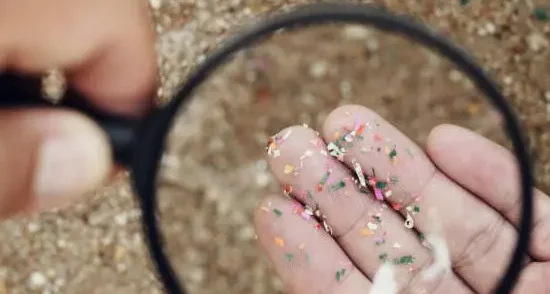Microplastics in Drinking Water:
Particles are alarmingly pervasive say new studies

Treatment plants are estimated to remove only about 90% of microplastics from wastewater, allowing a significant amount to enter natural waterways.
Did you know that every year, an estimated 8 million metric tons of plastic, including microplastics find their way into our oceans? These minuscule particles, less than 5mm in size, are stealthily infiltrating our water systems, with studies revealing their presence in 90% of bottled water and 83% of tap water samples worldwide. In the U.S., researchers found that 94% of all water samples — including tap water from places like the Environmental Protection Agency’s headquarters — were contaminated by plastic.*
Recently, research at theUniversity of Hawaiʻi at Mānoa**has discoveredmicroscopic bits of plastic floating in samples of human placenta– the organ that provides oxygen and nutrients to an unborn child.Between 2006 and 2013, the number of placentas containing microplastics increased from six to nine out of ten samples.
They might be tiny, but the impact of these microplastics is colossal.
What are Microplastics?
Microplastics, these almost invisible bits, come from various sources like the breakdown of bigger plastic items and even tiny beads in our everyday products. Therefore, they can sneak into our water through many paths, from washing our clothes to getting into rivers and oceans.
Health Effects of Microplastics
To understand just how pervasive this problem is, recent studies reveal that an average person might unknowingly ingest about 5 grams of microplastics in water each week, roughly the weight of a credit card. These minuscule plastics can carry harmful chemicals and could lead to health issues like inflammation and stress inside our bodies.
Taking Action: Reducing Microplastic Pollution
We’re not helpless in this situation. There are steps we can take to tackle this problem:
- Reducing Single-Use Plastics:
By cutting down on items like plastic bottles and bags, we can make a big difference. Choosing reusable options is a great start! - Adopting Water Filtration Systems:
Installing filters, such as a reverse osmosis system, at home can help trap these microplastics from reaching our drinking water. - Raising Awareness and Education:
Learning more about microplastics and sharing this knowledge with others can create a ripple effect, encouraging more people to take action.
Despite their small size, microplastics in water pose a massive threat to our environment and health. But here’s the good news: each of us has the power to make a difference. By cutting down on single-use plastics, using filtration systems, and spreading the word, we can work together to reduce the impact of these tiny troublemakers.
Best Filtration for Microplastics?
 Reverse Osmosis filter systems use a combination of activated carbon and a mechanical filter with 0.5-micron pores to eliminate 99.9% of microplastics and hundreds of other contaminants.
Reverse Osmosis filter systems use a combination of activated carbon and a mechanical filter with 0.5-micron pores to eliminate 99.9% of microplastics and hundreds of other contaminants.
715-842-2215

Why choose US Water?
AtU.S. Water, we are committed to delivering solutions that not only meet but exceed your expectations. With our Drinking Water Systems, you can enjoy the peace of mind that comes from knowing your family or coworkers are hydrating with the purest and most refreshing water available.

